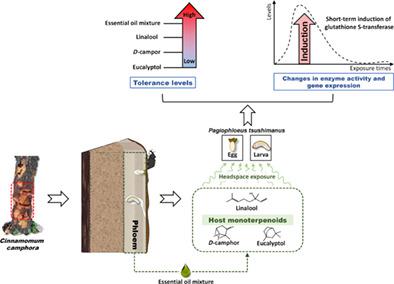当前位置:
X-MOL 学术
›
Agric. For. Entomol.
›
论文详情
Our official English website, www.x-mol.net, welcomes your feedback! (Note: you will need to create a separate account there.)
Tolerance, biochemistry and related gene expression in Pagiophloeus tsushimanus (Coleoptera: Curculionidae) exposed to chemical stress from headspace host-plant volatiles
Agricultural and Forest Entomology ( IF 1.6 ) Pub Date : 2021-12-28 , DOI: 10.1111/afe.12482 Shouyin Li 1 , Jingting Wang 1 , Cong Chen 1 , Hui Li 1 , Dejun Hao 1
中文翻译:

Pagiophloeus tsushimanus (鞘翅目: Curculionidae) 暴露于顶空寄主植物挥发物化学胁迫的耐受性、生物化学和相关基因表达
更新日期:2021-12-28
Agricultural and Forest Entomology ( IF 1.6 ) Pub Date : 2021-12-28 , DOI: 10.1111/afe.12482 Shouyin Li 1 , Jingting Wang 1 , Cong Chen 1 , Hui Li 1 , Dejun Hao 1
Affiliation

|
- Camphor, Cinnamomum camphora (L.) Presl, is used for mothproofing material due to its content of secondary metabolites. However, the phloem-feeding weevil, Pagiophloeus tsushimanus (Coleoptera: Curculionidae), has been observed to feed exclusively on this plant without incurring apparent fitness costs. This phenomenon remains to be elucidated.
- Gas chromatography–mass spectrometry analysis of essential oil extracted from the phloem of camphor tree was performed. The top three components, all monoterpenoids, were eucalyptol (31.9%), D-camphor (19.2%) and linalool (10.2%), respectively.
- In headspace bioassays, both eggs and larvae showed the greatest sensitivity to eucalyptol, and there was a bell-shaped relationship between the concentrations used and developmental time for eggs when exposed to D-camphor volatile.
- Exposure to essential oil mixture and D-camphor notably increased the activity of glutathione S-transferase in the weevil. A corresponding short-term induction of gene expression was also observed according to quantitative real-time polymerase chain reaction analysis.
- In general, P. tsushimanus possessed various levels of tolerance to different host monoterpenoids. Over-expression of glutathione S-transferase in vivo probably relates to detoxification metabolism of these monoterpenoids. Our findings provide a valuable clue to understanding the mechanism underlying resistance to host-specific chemical defences in this weevil pest.
中文翻译:

Pagiophloeus tsushimanus (鞘翅目: Curculionidae) 暴露于顶空寄主植物挥发物化学胁迫的耐受性、生物化学和相关基因表达
- 樟脑,Cinnamomum camphora (L.) Presl,由于其次级代谢物的含量而被用于防蛀材料。然而,已经观察到以韧皮部为食的象鼻虫Pagiophloeus tsushimanus (Coleoptera: Curculionidae) 只以这种植物为食,而不会产生明显的适应性成本。这种现象仍有待阐明。
- 对从樟树韧皮部提取的精油进行气相色谱-质谱分析。排名前三的成分均为单萜类化合物,分别是桉树脑 (31.9%)、D-樟脑 (19.2%) 和芳樟醇 (10.2%)。
- 在顶空生物测定中,卵和幼虫都对桉树脑表现出最大的敏感性,当暴露于D-樟脑挥发物时,卵的使用浓度和发育时间之间存在钟形关系。
- 暴露于精油混合物和D-樟脑显着增加了象鼻虫中谷胱甘肽 S-转移酶的活性。根据定量实时聚合酶链反应分析,还观察到相应的基因表达的短期诱导。
- 一般来说,P. tsushimanus对不同的宿主单萜类化合物具有不同程度的耐受性。体内谷胱甘肽S-转移酶的过度表达可能与这些单萜类化合物的解毒代谢有关。我们的研究结果为理解这种象鼻虫对宿主特异性化学防御的抵抗机制提供了有价值的线索。



























 京公网安备 11010802027423号
京公网安备 11010802027423号